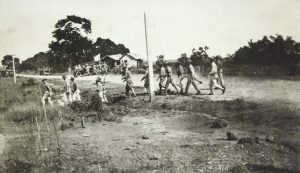These are some of the important events in American history during the decade starting 1950.
The Cold War and the spread of Communism in Eastern Europe, China, and Korea in the late 1940s and early 1950s prompted the United States to increase dramatically its defense spending. As more and more companies came to rely on defense contracts, the power of the military-industrial complex grew. One domestic result of this relationship was a wave of prosperity and the growth of the middle class in the United States.

On June 25, 1950 – The Korean War begins its three-year conflict when troops of North Korea, backed with Soviet weaponry, invade South Korea. This act leads to U.S. involvement when two days later, the United States Air Force and Navy are ordered by President Truman to the peninsula.
Two Puerto Rican nationalists, Oscar Collazo and Griselio Torresola, attempted to assassinate President Truman on November 1, 1950. They arrived in Washington D.C. the day before from the Bronx in New York City, where they were active in the Puerto Rican Nationalist Party. They thought the assassination would call attention to Puerto Rico and advance the cause of Puerto Rican independence.
A number of writers, members of the so-called “beat generation,” rebelled against conventional values. Stressing spontaneity and spirituality, they asserted intuition over reason, Eastern mysticism over Western institutionalized religion. The “beats” went out of their way to challenge the patterns of respectability and shock the rest of the culture. Musicians and artists rebelled as well.
Tennessee singer Elvis Presley popularized black music in the form of rock and roll and shocked more staid Americans with his ducktail haircut and undulating hips. In addition, Elvis and other rock and roll singers demonstrated that there was a white audience for black music, thus testifying to the increasing integration of American culture.
What begins to happen during the 1950s is a movement away from the big Studio Film to the little film about believable characters whose conflicts are more inward than outward. In some respects, the best films of the 1950s are the ones that forecast the great films on the 1960s.
Examples include On the Waterfront (1954), Rebel Without a Cause (1954), Marty (1955), Paths of Glory (1957), 12 Angry Men (1957), Separate Tables (1958), and Wild River (1960). These films have in common two important qualities–directors interested in telling small but important stories and fresh actors who bring new dimensions to characterization and emotional intensity.
On September 8, 1954 – In Bangkok, Thailand, the Southeast Asia Treaty Organization is formed by the U.S., Great Britain, Australia, New Zealand, France, the Philippines, Pakistan, and Thailand, creating a mutual defense pact. On January 3, 1959 – Alaska is admitted to the United States as the 49th state to be followed on August 21 by Hawaii.
On April 9, 1959 – NASA selects the first seven military pilots to become the Mercury Seven, first astronauts of the United States. The Mercury Seven included John Glenn, Scott Carpenter, Gordon Cooper, Gus Grissom, Wally Schirra, Alan Shepherd, and Deke Slayton.
1950s American culture, 1950s timeline, 1950s culture and society, 1950s facts, 1950s economy, politics in the 1950s, 1950s pop culture, 1950s history